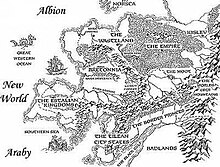
Games Workshop Group is a British manufacturer of miniature wargames, based in Nottingham, England. Its best-known products are Warhammer Age of Sigmar and Warhammer 40,000.

Blood Bowl is a miniatures board game created by Jervis Johnson for the British games company Games Workshop as a parody of American football. The game was first released in 1986 and has been re-released in new editions since. Blood Bowl is set in an alternate version of the Warhammer Fantasy setting, populated by traditional fantasy elements such as human warriors, goblins, dwarves, elves, orcs and trolls.

Warhammer Fantasy is a fictional fantasy universe created by Games Workshop and used in many of its games, including the table top wargame Warhammer Fantasy Battle, the Warhammer Fantasy Roleplay (WFRP) pen-and-paper role-playing game, and a number of video games: the MMORPG Warhammer Online: Age of Reckoning, the strategy games Total War: Warhammer, Total War: Warhammer II and Total War: Warhammer III and the two first-person shooter games in the Warhammer Vermintide series, Warhammer: End Times - Vermintide and Warhammer: Vermintide 2, among many others.
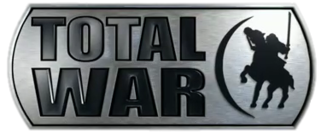
Total War is a series of strategy games developed by British developer Creative Assembly for personal computers. They combine turn-based strategy and resource management with real-time tactical control of battles. Rather uniquely for real-time strategy games, flanking manoeuvers and formations factor heavily into gameplay. The first of the series, Shogun: Total War, was released in June 2000. The most recent major game released was Total War: Warhammer III on February 17, 2022. As of October 2022, the series has sold over 40.4 million copies.
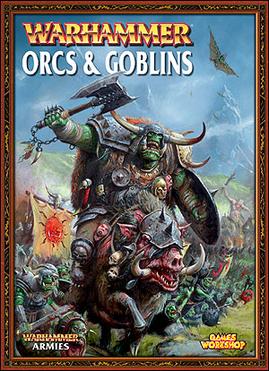
Orcs & Goblins is a supplemental book for the Warhammer Fantasy Battle tabletop game, first published in 1993. The phrase "orcs & goblins" also refers collectively to all of the races that are described in this book, which includes other "greenskins" as well. The book includes background information, illustrations, and game rules for these races. The Orcs and Goblins represent a generic Dark Ages warband army with little internal cohesion and discipline, and relying on the ferocious charge and individual fighting skills rather than organized generalship.

Warhammer is a tabletop miniature wargame with a medieval fantasy theme. The game was created by Bryan Ansell, Richard Halliwell, and Rick Priestley, and first published by the Games Workshop company in 1983.

Warhammer: Shadow of the Horned Rat is a single-player fantasy real-time tactics computer game based upon the Warhammer Fantasy Battle table-top game and figurines. It was developed and published by Mindscape, and released in November 1995 for Microsoft Windows, and on PlayStation in November 1996. The game's story takes place within the Warhammer Fantasy world setting, and focuses on players managing a group of mercenaries, who take on work for various clients but become involved in stopping a plot by the Skaven. The game's main focus is on battles that feature a mixture of medieval warfare and fantasy elements, using a variety of units based upon those from within the Warhammer setting.

WarCry is an out-of-print collectible card game set in the world of Warhammer Fantasy and published by Sabertooth Games. The base game cards were released in 2003, with newer expansions introduced in the months since. A video game adaptation, titled Warhammer: Battle for Atluma, was created for the PSP in 2006.
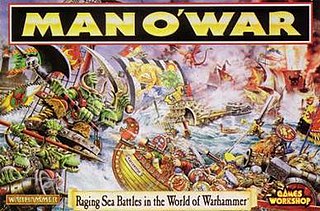
Man O' War is a now out-of-print table top war game by Games Workshop. The game was set in the same realm of Warhammer Fantasy as used for the Warhammer Fantasy Battle and included most of the factions from that setting. Other races of the Warhammer world were not included, either because they were lacking seafaring abilities, missing from the main factions at that time, or both.

Warmaster is a ruleset for tabletop wargames written by Rick Priestley, published by Specialist Games, and set in the Warhammer Fantasy setting. It is different from Warhammer Fantasy Battles in both appearance and gameplay. It is intended for 10 –12 mm miniatures. Basic troops are based on stands, of which typically three make a unit. Generals, Heroes and Wizards are mounted individually or with their retinue.

Warhammer 40,000: Dawn of War – Dark Crusade is the second expansion to the real-time strategy video game Warhammer 40,000: Dawn of War developed by Relic Entertainment and published by THQ. Based on Games Workshop's tabletop wargame, Warhammer 40,000, Dark Crusade was released on October 9, 2006. The expansion features two new races, the Tau Empire and the Necrons. Including the Imperial Guard from Dawn of War's first expansion pack Winter Assault, a total of seven playable races in this expansion.

Warhammer 40,000: Dawn of War – Soulstorm is the third expansion to the real-time strategy video game Warhammer 40,000: Dawn of War, developed by Iron Lore Entertainment. Like its predecessors, Soulstorm is based on Games Workshop's tabletop wargame Warhammer 40,000, and introduces a multitude of new features to the Dawn of War series, including two new playable factions in the form of the Imperial Sisters of Battle and the Dark Eldar. It is a stand-alone game and does not need the original Dawn of War disc to run, but players must have the prior games installed and valid cd-keys in order to play as anything but the two new factions online.

Warhammer 40,000: Dawn of War II – Retribution is the stand-alone second expansion to Warhammer 40,000: Dawn of War II, part of the Warhammer 40,000: Dawn of War series of real-time strategy video games. Set in Games Workshop's Warhammer 40,000 fictional universe, the single player campaign is playable with multiple races.
Archaon, also known as Archaon the Everchosen, is a fictional character in the Warhammer franchise, leader of the forces of Chaos, and one of the primary antagonists in multiple settings and mediums owned by Games Workshop. He is considered one of the most powerful characters in the Warhammer multiverse, having brought about the fabled End Times, and is a major antagonist in Warhammer Fantasy Battle, Warhammer Age of Sigmar, Total War: Warhammer, and Total War: Warhammer II.
The following is a list of Army Books and Supplements for the various armies released for the Games Workshop Warhammer Fantasy Battle game.

Total War: Warhammer is a 2016 turn-based strategy and real-time tactics video game developed by Creative Assembly and published by Sega for Windows via the Steam gaming platform. The game was brought to macOS and Linux by Feral Interactive. The game features the gameplay of the Total War series with factions of Games Workshop's Warhammer Fantasy series; it is the first Total War game not to portray a historical setting. It is the 10th title in the Total War series and the first title to be released in the Total War: Warhammer trilogy.

Total War: Warhammer II is a turn-based strategy and real-time tactics video game developed by Creative Assembly and published by Sega. It is part of the Total War series and the sequel to 2016's Total War: Warhammer. The game is set in Games Workshop's Warhammer Fantasy fictional universe. The game was released for Windows-based PCs on 28 September 2017. Feral Interactive released the game on macOS and Linux on 20 November 2018. Total War: Warhammer II was succeeded by Total War: Warhammer III, which was released in February 2022. The game requires a Steam account to play.

Warhammer: Vermintide 2 is a first-person action video game developed and published by Fatshark. It is the sequel to 2015's Warhammer: End Times – Vermintide. Vermintide 2 was released for Windows on 8 March 2018. It was released for Xbox One on 11 July 2018, free for members of the Xbox Game Pass. It was released for the PlayStation 4 on 18 December 2018. It also released for Xbox Series X/S on 3 December 2020. A spiritual successor, Warhammer 40,000: Darktide, was released in 2022.
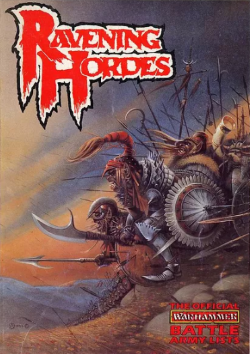
Ravening Hordes: The Official Warhammer Battle Army Lists is a supplement published by Games Workshop in 1987 game for the second edition of the tabletop fantasy miniatures wargame Warhammer.

Total War: Warhammer III is a turn-based strategy and real-time tactics video game developed by Creative Assembly and published by Sega. It is part of the Total War series, and the third to be set in Games Workshop's Warhammer Fantasy fictional universe. The game was announced on 3 February 2021 and was released on 17 February 2022. It received positive reviews from critics and was nominated for the British Academy Games Award for British Game at the 19th British Academy Games Awards.



